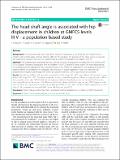Files in this item
The head shaft angle is associated with hip displacement in children at GMFCS levels III-V - a population based study
Item metadata
| dc.contributor.author | Finlayson, L. | |
| dc.contributor.author | Czuba, T. | |
| dc.contributor.author | Gaston, M. S. | |
| dc.contributor.author | Hägglund, G. | |
| dc.contributor.author | Robb, J. E. | |
| dc.date.accessioned | 2018-10-08T11:30:10Z | |
| dc.date.available | 2018-10-08T11:30:10Z | |
| dc.date.issued | 2018-10-05 | |
| dc.identifier | 256147138 | |
| dc.identifier | 3db66f8a-22b1-4919-b2c7-fb4a43910b92 | |
| dc.identifier | 85054445827 | |
| dc.identifier | 000460049400001 | |
| dc.identifier.citation | Finlayson , L , Czuba , T , Gaston , M S , Hägglund , G & Robb , J E 2018 , ' The head shaft angle is associated with hip displacement in children at GMFCS levels III-V - a population based study ' , BMC Musculoskeletal Disorders , vol. 19 , 356 . https://doi.org/10.1186/s12891-018-2275-4 | en |
| dc.identifier.issn | 1471-2474 | |
| dc.identifier.other | RIS: urn:FD83B52B944465EACE86738CACD11958 | |
| dc.identifier.other | RIS: Finlayson2018 | |
| dc.identifier.uri | https://hdl.handle.net/10023/16163 | |
| dc.description.abstract | Background: An increased Head Shaft Angle (HSA) has been reported as a risk factor for hip displacement in children with cerebral palsy (CP) but opinions differ in the literature. The purpose of this study was to re-evaluate the relationship between HSA and hip displacement in a different population of children with CP. Methods: The Cerebral Palsy Integrated Pathway Scotland surveillance programme includes 95% of all children with CP in Scotland. The pelvic radiographs from 640 children in GMFCS levels III-V were chosen. The most displaced hip was analysed and the radiographs used were those taken at the child’s first registration in the database to avoid the potential effects of surveillance on subsequent hip centration. A logistic regression model was used with hip displacement (migration percentage [MP] ≥40%) as outcome and HSA, GMFCS, age and sex as covariates. Results: The MP was ≥40% in 118 hips with a mean HSA of 164° (range 121–180°) and < 40% in 522 hips with a mean HSA of 160° (range 111–180°). The logistic regression analysis showed no significant influence of age and sex on MP in this population but a high GMFCS level was strongly associated with hip displacement. An increased HSA was also associated with hip displacement, a 10° difference in HSA for children adjusted for age, sex, and GMFCS gave an odds ratio of 1.26 for hip displacement equal or above 40% (p = 0.009) and hips with HSA above 164.5 degrees had an odds ratio of 1.96 compared with hips with HSA below 164.5 degrees (p = 0.002). Conclusion: These findings confirm that HSA is associated with hip displacement in children in GMFCS levels III-V. | |
| dc.format.extent | 4 | |
| dc.format.extent | 720675 | |
| dc.language.iso | eng | |
| dc.relation.ispartof | BMC Musculoskeletal Disorders | en |
| dc.subject | Children | en |
| dc.subject | Cerebral palsy | en |
| dc.subject | Hip displacement | en |
| dc.subject | Head shaft angle | en |
| dc.subject | RJ101 Child Health. Child health services | en |
| dc.subject | NDAS | en |
| dc.subject.lcc | RJ101 | en |
| dc.title | The head shaft angle is associated with hip displacement in children at GMFCS levels III-V - a population based study | en |
| dc.type | Journal article | en |
| dc.contributor.institution | University of St Andrews. University of St Andrews | en |
| dc.contributor.institution | University of St Andrews. School of Medicine | en |
| dc.identifier.doi | 10.1186/s12891-018-2275-4 | |
| dc.description.status | Peer reviewed | en |
This item appears in the following Collection(s)
Items in the St Andrews Research Repository are protected by copyright, with all rights reserved, unless otherwise indicated.

